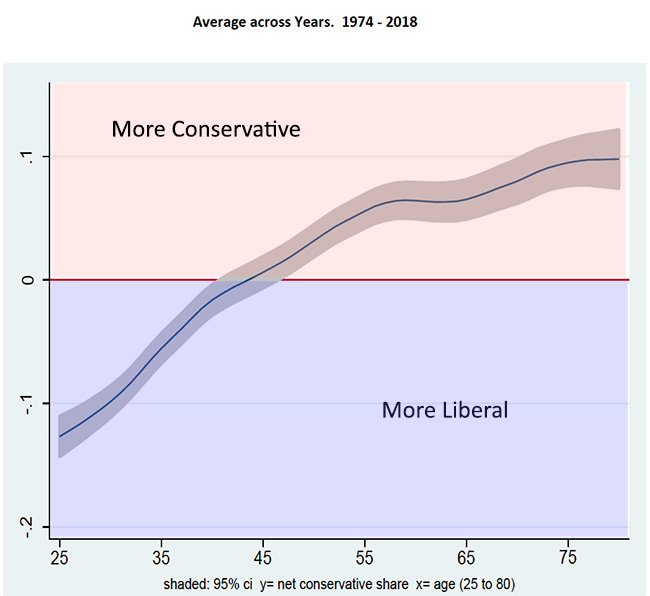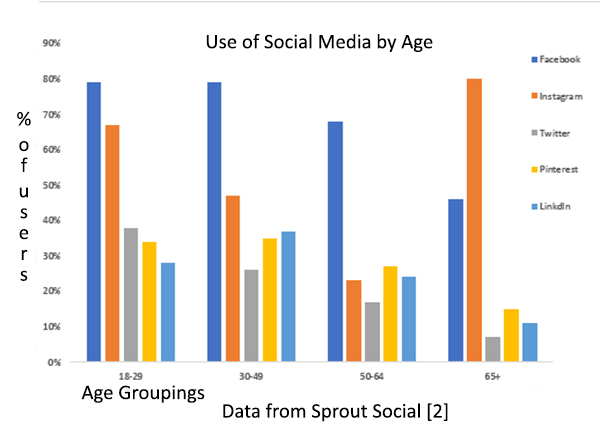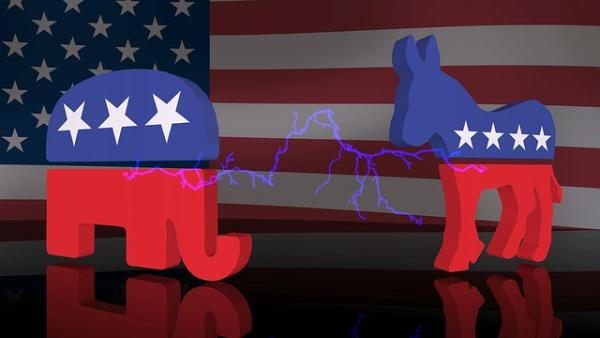“Common sense” suggests that as we age, our political views tend to harden and shift to more conservative positions. A drift towards conservativism with age has been noted since the ’50s, with studies and polls, showing that the average American is moderate. Of course, that type of aggregation fails to account for differences in political thought over specific issues. For example, while your view may or may not have changed, the aggregate opinion of Americans has shifted on homosexuality and marijuana over the past decade or two. Because of a lack of longitudinal studies of political beliefs, we can speak best about populations, not individuals change.
A study from the Social Science Research Network (SSRN) tries to answer the question of “how self-described political ideology changes with age.”
Before looking at the study, note one study limitation. Political “ideology” captured in the labels liberal and conservative are an inadequate description of what an individual may mean. Are they conservative concerning their political thought and progressive in its implementation, or vice versa? Compassionate conservatism comes to mind, providing food and housing assistance to those in need, but only if the able-bodied work.
The data comes from the General Social Survey, which has asked people to place themselves on a 7-point scale ranging from extremely liberal to extremely conservative, with moderate in the middle, at point 4. The survey has been conducted every two years since 1974 and does not follow the same individuals over time – it is a series of snapshots, not an actual longitudinal study.
Mathmagic
To get a sense of our changing behavior as we age, the researcher created a “synthetic” cohort of aging individuals. Beginning with the earliest survey and the youngest age group, they imagined that the same group surveyed over time. For example, the responses of the 25-30 years olds from the 1974 study were used as the baseline for the 30-35 years old in the 1980 survey. If the selection of participants was genuinely random, then this technique provides a first-order approximation of how political views change for this cohort as they age.
Results
- The young are more liberal than their elders in every period surveyed, although occasionally, the elders are more liberal than a “nearby” younger age group.
- “People are mostly liberal at 25, then drift right as they age, crossing zero somewhere in their 40’s.”
 Now the graphic is a bit misleading since the question was scaled from -1 to +1, and the graph’s scale shows only the range from-0.2 to +0.1 – 15% of the entire range. So political shifts are not massive, you rarely find a person that might have voted for Bernie Sanders as mayor of Burlington and Donald Trump for president.
Now the graphic is a bit misleading since the question was scaled from -1 to +1, and the graph’s scale shows only the range from-0.2 to +0.1 – 15% of the entire range. So political shifts are not massive, you rarely find a person that might have voted for Bernie Sanders as mayor of Burlington and Donald Trump for president.
Is the political shift from liberal to moderate or from moderate to conservative, how far do people move their beliefs? The data do not provide an answer, but the trending information is suggestive that “Moderation appears to be a way station, importing liberals and exporting conservatives on balance, but trendless overall.”
“American political ideology has been described as “purple,” … i.e., a large moderate middle surrounded by roughly equal groups on the left and right. This is too simple. There are two Americas. One is under 45. This America is indeed reasonably purple. But the other America, the one older than 45, can best be described as maroon – close to purple perhaps but with a distinct red tinge.”
 This leads to two intriguing observations. First, while the young pull us to the left, the conservative young, along with individuals aging to the right, tip the balance leaving us, as a population, slightly to the right of center. Second, the demography of the voters, because of its association with a political viewpoint, can predict voting behavior, and provide a lever to tilt the field in your favor. There are good reasons for politicians to target young or older voters in “get out to vote” drives.
This leads to two intriguing observations. First, while the young pull us to the left, the conservative young, along with individuals aging to the right, tip the balance leaving us, as a population, slightly to the right of center. Second, the demography of the voters, because of its association with a political viewpoint, can predict voting behavior, and provide a lever to tilt the field in your favor. There are good reasons for politicians to target young or older voters in “get out to vote” drives.
Bonus
Just for giggles, I pulled some data [2] on age demographics and five social media. You can see how if you wanted to reach the younger voters, Facebook, and to a lesser extent, Instagram are crucial. Still, if you're going to reach those older, more conservative voters, Instagram may be all that is necessary. One last thought, age in this study is really an aggregate measure that includes life and individual socioeconomic experience.
[1] I had heard this attributed to Winston Churchill, but as it turns out, it was not first uttered, if it was uttered at all, by him or Mr. Disraeli, but by a Frenchmen writing contemporary biographies in 1875. You can find the article here. And of course, there are attributions to other historical figures pre-dating 1875.
[2] Data can be found here.
Source: Political Ideology over the Life Course SSRN DOI: 10.2139/ssrn.3501174




